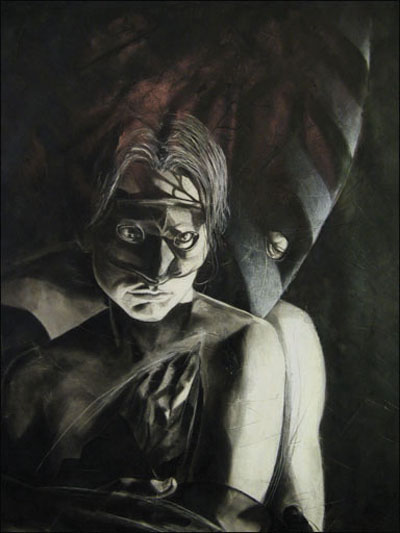
Effective art should captivate, enlighten, and move its audience. George Rivera’s paintings do just that. Viewers of George Rivera’s art may notice the darkness in his subjects, but also spot out the way he reveals the light. So it makes sense that Rivera’s latest exhibit at Mission College is titled “A Journey of Hope.”
Rivera is an art instructor at Mission College and the executive director and senior curator at Triton Museum. His own journey of hope stems from the inspiration his family and mentors have given him. A common motif in Rivera’s art is the presence of hope in spite of the darkness.
“Hope can be spiritual, or part of one’s state, just that coping mechanism that you have to keep believing and keep trying, that you never give up,” Rivera says. “You know how viewers can determine if the glass is half-full or half-empty? That’s a choice you make when you look at my works. What I teach my students is to try to get the viewer to participate in their work rather than just sit back as a spectator.”
“Humanity has gone through a lot of difficult things,” he continues. “But the common thread [we share] is you believe you have hope. Since I started teaching many years ago, my students have realized that as well. Some of the challenges in their health, their jobs, or their families are extremely daunting. I realize not everyone had the same loving relationship I had with my family, and some people’s families are extremely difficult.”
One of Rivera’s favorite pieces in his exhibit is titled “Reality Faith Life.”
“In this work, two figures are in a darkened situation and there’s a presence of light coming from the right side,” Rivera says. “You can see the figure in the front looking towards that light. In many of my works, there’s a choice for an individual to make- the darker reality or the light. The light represents hope. The individual could either move towards the light or not. Hopefully, the viewer can see the choice and this can be a reflection of themselves. The figure in the front, even though it’s dark, has her hand over her heart.”
In 1955, Rivera was born in an American army hospital in Japan to a Mexican American father and a Japanese mother. Raised in the Monterey Peninsula, Rivera studied for his undergraduate and graduate degrees in art at San Jose State University. Rivera frequently draws on his Japanese and Mexican heritage to incorporate those cultures’ images and symbols into his art. For example, Rivera might sometimes use Asian calligraphy in his work.
“The Asian characters I choose may symbolize honor, integrity, and friendship,” he says.
Other symbols Rivera uses include bones, blood, masks, crucifixes, snakes, skulls, some of which he also refers to as religious icons.
Rivera’s “A Journey of Hope” exhibit is located at the Vargas Gallery in the Main Building of the Mission College campus. The exhibit is running until Nov. 3. Visit www.missioncollege.edu/gen_info/vargas/ or call (408) 855-5244 for gallery hours or to make an appointment to view the art. A closing reception, coupled by a Day of the Dead celebration, will take place on Wed., Nov. 2nd from 5:00-8:00 p.m.
